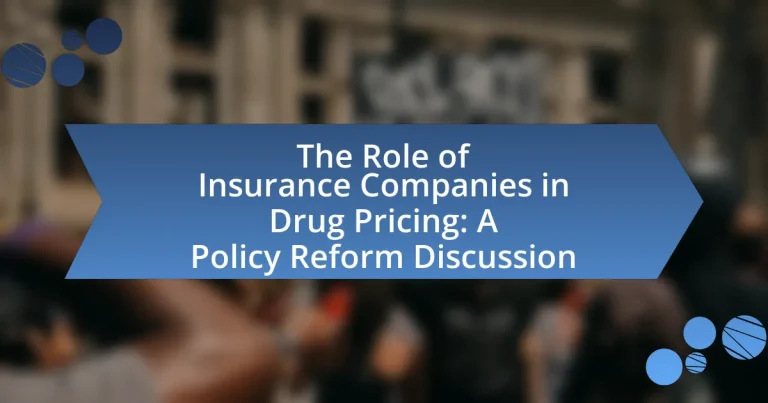The article examines the critical role of insurance companies in drug pricing, highlighting their influence on medication affordability and accessibility through formulary management and price negotiations with pharmaceutical manufacturers. It discusses various pricing models employed by insurers, such as cost-plus and value-based pricing, and the impact of these strategies on consumer costs and health outcomes. Additionally, the article addresses the ethical considerations surrounding insurance pricing practices, the significance of pharmacy benefit managers, and potential policy reforms aimed at improving drug pricing transparency and fairness. Key factors shaping insurance companies’ decisions on drug pricing are also explored, along with the implications for public health and patient access to necessary medications.

What is the Role of Insurance Companies in Drug Pricing?
Insurance companies play a critical role in drug pricing by negotiating prices with pharmaceutical manufacturers and determining which medications are covered under their plans. These companies utilize formulary management, which involves creating a list of covered drugs and tiered pricing structures that influence patient access and out-of-pocket costs. For instance, insurance companies often negotiate rebates from drug manufacturers, which can lower the overall cost of medications for both the insurer and the insured. According to a 2020 report from the Kaiser Family Foundation, nearly 90% of Americans with health insurance have some form of prescription drug coverage, highlighting the significant impact of insurance companies on drug affordability and accessibility.
How do insurance companies influence drug pricing strategies?
Insurance companies influence drug pricing strategies primarily through their formulary decisions and negotiation power. By determining which drugs are covered and at what reimbursement rates, insurers can significantly impact the market demand for specific medications. For instance, when an insurance company excludes a high-cost drug from its formulary or imposes higher copayments, it can lead to decreased utilization of that drug, prompting manufacturers to reconsider their pricing strategies. Additionally, insurers often negotiate discounts and rebates with pharmaceutical companies, which can lower the effective price of drugs for consumers. According to a 2020 study published in the Journal of Managed Care & Specialty Pharmacy, these negotiations can result in price reductions of up to 30% for certain medications, illustrating the substantial role insurance companies play in shaping drug pricing dynamics.
What pricing models do insurance companies use for medications?
Insurance companies primarily use several pricing models for medications, including cost-plus pricing, value-based pricing, and tiered pricing. Cost-plus pricing involves setting medication prices based on the cost of production plus a markup. Value-based pricing determines prices based on the perceived value of the medication to patients and healthcare systems, often considering clinical outcomes and economic impact. Tiered pricing structures categorize medications into different tiers, with varying copayment levels, incentivizing the use of lower-cost alternatives. These models are influenced by factors such as market competition, regulatory frameworks, and negotiations with pharmaceutical manufacturers.
How do insurance negotiations affect drug costs for consumers?
Insurance negotiations significantly lower drug costs for consumers by enabling insurers to secure discounts from pharmaceutical companies. These negotiations often involve formulary placement, where insurers agree to include specific drugs in their coverage in exchange for reduced prices. For instance, a study by the Kaiser Family Foundation found that negotiated prices can be up to 30% lower than the list prices set by manufacturers. Consequently, when insurers successfully negotiate lower prices, consumers benefit from reduced out-of-pocket expenses and lower premiums, making medications more affordable and accessible.
What are the key factors that shape insurance companies’ decisions on drug pricing?
Insurance companies’ decisions on drug pricing are primarily shaped by factors such as cost-effectiveness analysis, market competition, regulatory frameworks, and patient access considerations. Cost-effectiveness analysis evaluates the therapeutic benefits of drugs relative to their costs, influencing pricing strategies to ensure financial sustainability. Market competition drives insurers to negotiate prices with pharmaceutical companies, often leading to lower costs for consumers. Regulatory frameworks, including government policies and guidelines, dictate pricing structures and reimbursement rates, impacting how insurers set drug prices. Lastly, patient access considerations ensure that pricing strategies align with the goal of providing affordable medications to patients, which can affect overall healthcare outcomes.
How do formulary placements impact drug accessibility?
Formulary placements significantly impact drug accessibility by determining which medications are covered by insurance plans and at what cost to patients. When a drug is placed on a formulary, it typically becomes more affordable and accessible for patients, as insurance companies negotiate lower prices with manufacturers for listed medications. Conversely, drugs that are not included on formularies may lead to higher out-of-pocket costs or complete lack of access for patients, as they may not be covered by insurance at all. For instance, a study published in the Journal of Managed Care & Specialty Pharmacy found that patients prescribed medications on preferred tiers experienced lower copayments and increased adherence compared to those with non-formulary drugs. This illustrates that formulary placements directly influence both the financial burden on patients and their ability to obtain necessary medications.
What role do pharmacy benefit managers play in drug pricing?
Pharmacy benefit managers (PBMs) play a crucial role in drug pricing by acting as intermediaries between insurers, pharmacies, and drug manufacturers. They negotiate discounts and rebates on medications, which can influence the final price that consumers pay at the pharmacy. For instance, in 2020, PBMs were responsible for managing over 80% of all prescription drug claims in the United States, highlighting their significant impact on pricing dynamics. By leveraging their purchasing power, PBMs can lower costs for insurers, but this can also lead to higher out-of-pocket expenses for patients if the savings are not passed down.
Why is the relationship between insurance companies and pharmaceutical manufacturers significant?
The relationship between insurance companies and pharmaceutical manufacturers is significant because it directly influences drug pricing and access to medications for patients. Insurance companies negotiate prices and coverage terms with pharmaceutical manufacturers, impacting the affordability and availability of drugs. For instance, in 2020, the U.S. spent approximately $358 billion on prescription drugs, highlighting the financial stakes involved. These negotiations can determine which drugs are covered under insurance plans, affecting patient treatment options and overall healthcare costs.
How do rebates and discounts affect the final price of drugs?
Rebates and discounts significantly lower the final price of drugs for consumers and insurers. When pharmaceutical companies offer rebates to insurers, these reductions can be passed on to consumers, resulting in lower out-of-pocket costs. For instance, a study by the Kaiser Family Foundation found that in 2020, rebates accounted for approximately 30% of the list price of brand-name drugs, illustrating their substantial impact on the final price. Additionally, discounts negotiated by pharmacy benefit managers can further decrease costs, making medications more affordable for patients.
What ethical considerations arise from insurance companies’ pricing practices?
Insurance companies’ pricing practices raise several ethical considerations, primarily concerning fairness, transparency, and access to care. These companies often utilize complex algorithms and data analytics to determine premiums, which can lead to discriminatory pricing based on factors such as age, health status, or socioeconomic background. For instance, a study published in the Journal of Health Economics found that individuals with pre-existing conditions may face significantly higher premiums, raising concerns about equity in access to necessary healthcare services. Additionally, the lack of transparency in how prices are set can erode trust between insurers and consumers, as individuals may struggle to understand the rationale behind their costs. This opacity can lead to a perception of exploitation, particularly among vulnerable populations who may already be facing financial hardships. Overall, these ethical issues highlight the need for regulatory oversight to ensure that pricing practices are fair and just, promoting equitable access to healthcare for all individuals.
How can policy reforms improve the role of insurance companies in drug pricing?
Policy reforms can enhance the role of insurance companies in drug pricing by implementing regulations that promote transparency and competition among insurers. For instance, reforms that require insurers to disclose their drug pricing strategies and negotiate prices with pharmaceutical companies can lead to lower costs for consumers. A study by the Kaiser Family Foundation found that increased transparency in drug pricing can reduce overall healthcare spending by enabling consumers to make informed choices and encouraging insurers to seek better deals. Additionally, reforms that incentivize insurers to adopt value-based pricing models can align drug costs with patient outcomes, further improving affordability and access to necessary medications.
What challenges do policymakers face in reforming drug pricing practices?
Policymakers face significant challenges in reforming drug pricing practices, primarily due to the complex interplay of market dynamics, stakeholder interests, and regulatory frameworks. The pharmaceutical industry often resists changes that could impact profit margins, leading to lobbying efforts that complicate legislative initiatives. Additionally, the lack of transparency in pricing structures makes it difficult for policymakers to assess fair pricing and negotiate effectively. For instance, a 2021 report from the House of Representatives noted that drug prices in the U.S. are often higher than in other countries, highlighting the need for comprehensive reform but also illustrating the resistance from powerful pharmaceutical companies. Furthermore, the involvement of insurance companies adds another layer of complexity, as they negotiate prices and coverage, which can conflict with efforts to lower costs for consumers.
What are the implications of insurance companies’ drug pricing on public health?
Insurance companies’ drug pricing significantly impacts public health by influencing access to necessary medications. High drug prices can lead to increased out-of-pocket costs for patients, resulting in lower medication adherence and poorer health outcomes. For instance, a study published in the Journal of the American Medical Association found that nearly 25% of patients do not fill prescriptions due to cost, which can exacerbate chronic conditions and lead to higher healthcare costs in the long run. Additionally, insurance companies often negotiate prices with pharmaceutical companies, but these negotiations can result in higher premiums and deductibles for consumers, further limiting access to essential treatments. Therefore, the pricing strategies employed by insurance companies directly affect the overall health of the population by creating barriers to medication access and adherence.
How does drug pricing affect patient access to necessary medications?
Drug pricing significantly impacts patient access to necessary medications by determining affordability and availability. High drug prices can lead to patients forgoing essential treatments due to financial constraints; for instance, a study published in the Journal of the American Medical Association found that nearly 25% of patients reported not filling prescriptions due to cost. Furthermore, insurance coverage often dictates which medications are accessible, with high out-of-pocket costs for certain drugs limiting access for many individuals. This situation is exacerbated by the fact that approximately 30% of Americans have high-deductible health plans, which can further restrict access to necessary medications.
What populations are most impacted by high drug prices?
Low-income individuals, the elderly, and those with chronic illnesses are the populations most impacted by high drug prices. Low-income individuals often lack adequate insurance coverage, making it difficult for them to afford necessary medications. The elderly frequently rely on fixed incomes, which can be insufficient to cover the rising costs of prescription drugs. Additionally, individuals with chronic illnesses face ongoing medication needs, and high prices can lead to non-adherence, worsening their health outcomes. According to a 2021 survey by the Kaiser Family Foundation, nearly one in four Americans reported not filling a prescription due to cost, highlighting the widespread impact of high drug prices across these vulnerable groups.
How do high drug costs influence health outcomes?
High drug costs negatively influence health outcomes by limiting access to necessary medications for patients. When patients cannot afford their prescriptions, they may skip doses, delay treatment, or forgo medications altogether, leading to worsened health conditions. A study published in the Journal of the American Medical Association found that nearly 25% of Americans reported not filling a prescription due to cost, which correlates with increased hospitalizations and higher overall healthcare costs. This demonstrates that high drug prices directly impact patient adherence to treatment regimens, ultimately resulting in poorer health outcomes.
What potential solutions exist to address drug pricing issues?
Potential solutions to address drug pricing issues include implementing price negotiation policies, increasing transparency in pricing, and promoting the use of generic drugs. Price negotiation policies, such as those enacted in countries like Canada, allow governments to negotiate directly with pharmaceutical companies, resulting in lower prices for consumers. Increasing transparency in drug pricing can help consumers and healthcare providers make informed decisions, as seen in initiatives that require drug manufacturers to disclose prices and rebates. Additionally, promoting the use of generic drugs can significantly reduce costs, as generics are typically 80-85% cheaper than their brand-name counterparts, leading to substantial savings for both consumers and insurance companies.
How can transparency in pricing benefit consumers?
Transparency in pricing benefits consumers by enabling them to make informed decisions about their purchases. When consumers have access to clear and detailed pricing information, they can compare costs across different providers and select options that best fit their budgets and needs. For instance, a study by the National Bureau of Economic Research found that price transparency in healthcare led to a reduction in spending by up to 7% as consumers became more price-sensitive and sought lower-cost alternatives. This increased awareness not only empowers consumers but also encourages competition among providers, ultimately leading to better pricing and quality of services.
What role can government regulation play in drug pricing reform?
Government regulation can significantly influence drug pricing reform by establishing price controls, promoting transparency, and fostering competition among pharmaceutical companies. Price controls can limit the maximum prices that can be charged for certain medications, as seen in countries like Canada, where the Patented Medicine Prices Review Board regulates prices to ensure they are not excessive. Transparency initiatives can require drug manufacturers to disclose pricing information and the costs associated with research and development, which can help consumers and policymakers understand pricing structures. Additionally, regulations that encourage competition, such as allowing the importation of cheaper drugs or facilitating the entry of generic alternatives, can drive down prices. For instance, the introduction of generic drugs has been shown to reduce prices by up to 80% in some cases, demonstrating the effectiveness of regulatory measures in achieving lower drug costs.

What are the future trends in insurance companies and drug pricing?
Future trends in insurance companies and drug pricing include increased transparency, value-based pricing models, and the integration of technology for personalized medicine. Insurance companies are likely to adopt transparent pricing strategies to enhance consumer trust and competition, as seen in recent legislative efforts aimed at reducing drug costs. Value-based pricing models, where drug prices are tied to patient outcomes, are gaining traction, supported by studies indicating that this approach can lead to more efficient healthcare spending. Additionally, the use of technology, such as artificial intelligence and data analytics, is expected to facilitate personalized medicine, allowing insurers to better assess risk and tailor drug coverage, ultimately impacting pricing structures. These trends are driven by ongoing policy reforms and consumer demand for more affordable healthcare solutions.
How might technology change the landscape of drug pricing?
Technology may significantly alter the landscape of drug pricing by enhancing transparency, streamlining supply chains, and enabling personalized medicine. For instance, blockchain technology can provide immutable records of drug transactions, reducing fraud and ensuring accurate pricing. Additionally, artificial intelligence can analyze vast datasets to optimize pricing strategies and predict market trends, potentially lowering costs. A study by the National Bureau of Economic Research found that the implementation of technology in healthcare can lead to a 10-20% reduction in drug prices by improving efficiency and competition in the market.
What innovations are emerging in insurance models related to drug pricing?
Innovations in insurance models related to drug pricing include value-based pricing, which ties reimbursement rates to the clinical outcomes of medications. This model incentivizes pharmaceutical companies to demonstrate the effectiveness of their drugs, potentially lowering costs for insurers and patients. Additionally, the implementation of subscription models, where insurers pay a flat fee for access to a range of drugs, is emerging as a way to manage high-cost therapies. These innovations aim to enhance affordability and accessibility while ensuring that drug pricing reflects their therapeutic value.
How can data analytics improve pricing strategies?
Data analytics can improve pricing strategies by enabling insurance companies to analyze vast amounts of data to identify optimal pricing models based on consumer behavior, market trends, and competitive dynamics. By leveraging predictive analytics, insurers can forecast demand and adjust prices accordingly, ensuring competitiveness while maximizing profitability. For instance, a study by McKinsey & Company found that companies using advanced analytics in pricing can achieve a 2-5% increase in revenue. This data-driven approach allows for dynamic pricing adjustments, enhancing the ability to respond to market changes swiftly and effectively.
What best practices can insurance companies adopt to enhance drug pricing fairness?
Insurance companies can enhance drug pricing fairness by implementing transparent pricing models and negotiating directly with pharmaceutical manufacturers. Transparency in pricing allows consumers to understand the costs associated with medications, which can lead to more informed choices and increased competition among providers. Direct negotiations with manufacturers can help secure lower prices, as evidenced by the success of programs like the Medicaid Drug Rebate Program, which has saved billions in drug costs by leveraging collective bargaining power. Additionally, adopting value-based pricing strategies, where payments are tied to the effectiveness of the drug, can ensure that patients receive fair pricing relative to the benefits they receive. These practices collectively contribute to a more equitable drug pricing landscape.


